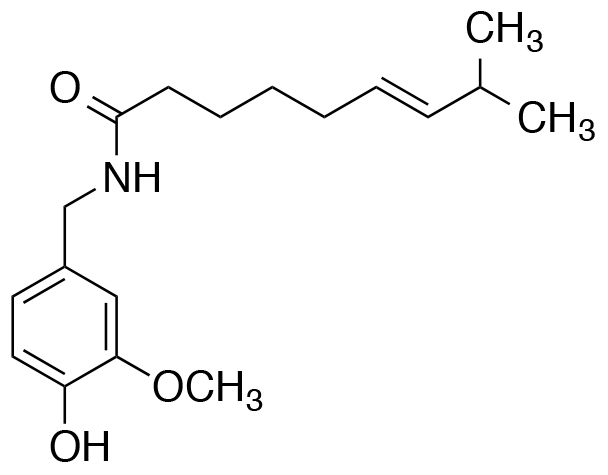


INCI name: Capsaicin
Synonyms: 8-Methyl-N-vanillyl-trans-6-nonenamide
Molecular formula: C18H27NO3
Molecular weight: 305.41 g/mol
IUPAC name: (E)-N-[(4-hydroxy-3-methoxyphenyl)methyl]-8-methylnon-6-enamide
CAS number: 404-86-4
EINECS number: 206-969-8
Capsaicin is found in hot peppers (e.g., cayenne, chili, jalapeño, etc.) and gives them their characteristic burning sensation in the mouth during consumption. It is used to treat several medical conditions including minor pain associated with rheumotoid arthritis and neuralgia (shingles).1 [Neuralgia is pain that is associated with the nerves of the skin.] Capsaicin is one of the most common compounds of the capsaicinoid class of molecules. Extracts containing capsaicin are commonly used in cosmetic products as external analgesics, flavoring agents, or fragrance components.2
Treatment of the skin with capsaicin results in vasodilation thereby increasing blood flow in the skin.3,4 Work in the cosmetic industry has taken advantage of these properties of capsaicin in which reports claim that it increases circulation, tone, and firmness.5 In addition, uses of capsaicin may be found in lipsticks where it is postulated that its irritating effect leads to inflammation causing the lips to appear more plump.6,7 Interestingly, capsaicin is recommended as an ingredient in nail lacquers for small children who habitually suck on their finger/thumb. Constant wetting of the nail plate causes deterioration of the nail, and capsaicin serves as a deterent to this behavior.8
Properties
Boiling point: 210-220 °C9
Melting point: 65 °C9
Solubility: Insoluble in cold H2O; soluble in H2O if heated to 52 °C10; soluble in alcohol, ether, and benzene9
References
1. www.mayoclinic.org
2. Final Report on the Safety Assessment of Capsicum Annuum Extract, Capsicum Annuum Fruit Extract, Capsicum Annuum Resin, Capsicum Annuum Fruit Powder, Capsicum Frutescens Fruit, Capsicum Frutescens Fruit Extract, Capsicum Frutescens Resin, and Capsaicin, Int. J. Toxicol., 26(Suppl. 1), 3-106 (2007).
3. R.G. Roberts, R.A. Westerman, R.E. Widdop, R.R. Kotzmann, and R. Payne, Effects of capsaicin on cutaneous vasodilator responses in humans, Agents Actions, 37, 53-59 (1992).
4. S.K.R. Khambam, M.U.R. Naidu, P.U.Rani, and T.R.K. Rao, Determination of capsaicin induced increase in dermal blood flow using laser doppler flowmetry technique, Pharmacol. Pharm., 2, 159-163 (2011).
5. K. Schaefer, Capsaicin to improve leg circulation, tone and firmness, Cosmet. & Toil. Appl., October 11, 2010; http://www.cosmeticsandtoiletries.com/formulating/category/skincare/104708444.html
6. http://www.compoundchem.com
7. http://www.beautybythegeeks.com
8. Z.D. Draelos, “Children and nail cosmetic issues” in Cosmetics and Dermatological Problems and Solutions: A Problem Based Approach, 3rd ed., Taylor & Francis: Boca Raton, FL (2011).
9. M.J. O'Neil, The Merck Index - An Encyclopedia of Chemicals, Drugs, and Biologicals, 13th ed., Merck and Co.: Whitehouse Station, NJ (2001).
10. M. Yoshioka, M. Imanaga, H. Ueyama, M. Yamane, Y. Kubo, A. Boivin, J. St-Amand, H. Tanaka, and A. Kiyonaga, Maximum tolerable dose of red pepper decreases fat intake independently of spicy sensation in the mouth, Br. J. Nutr., 91, 991-995 (2004).